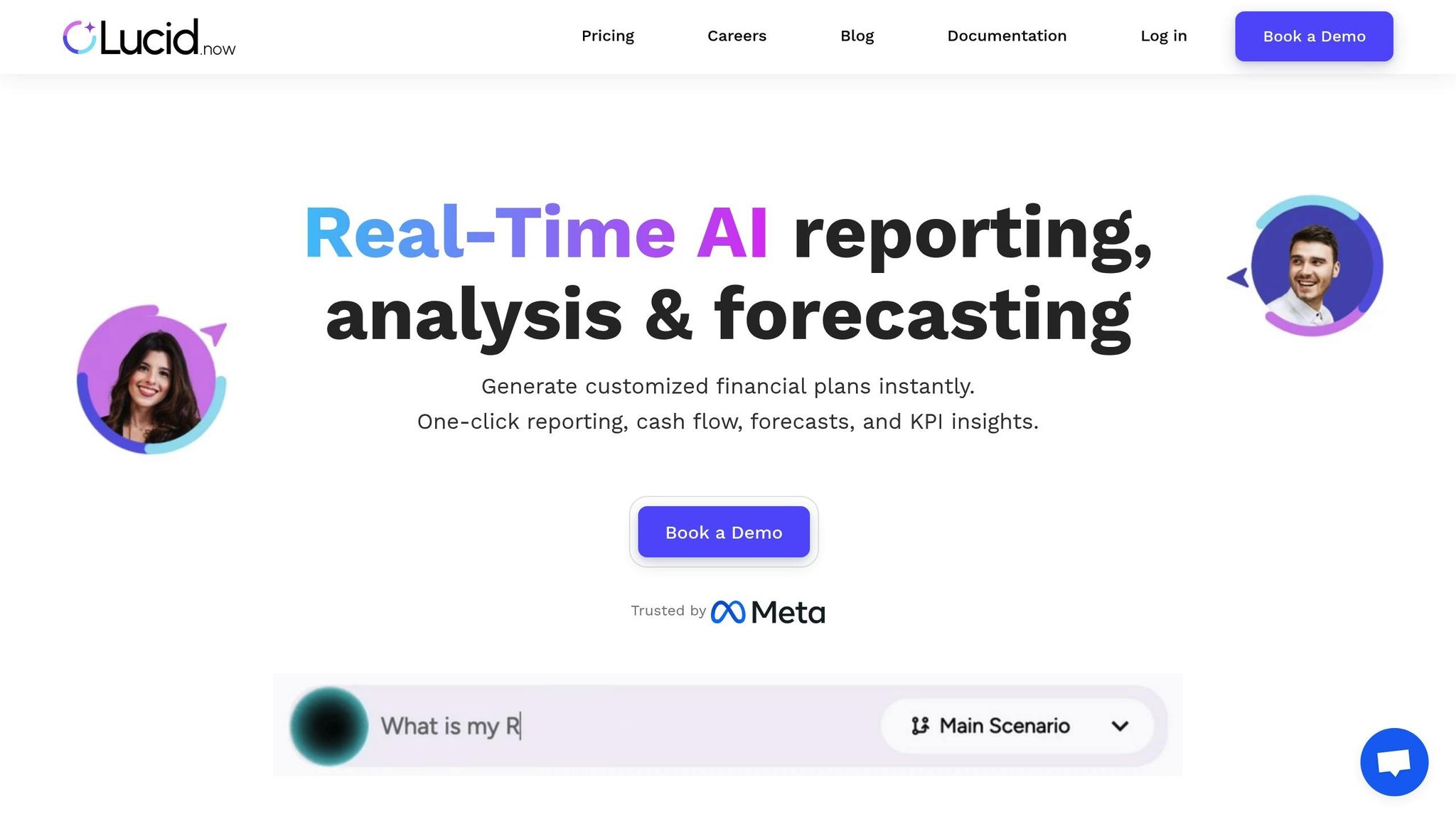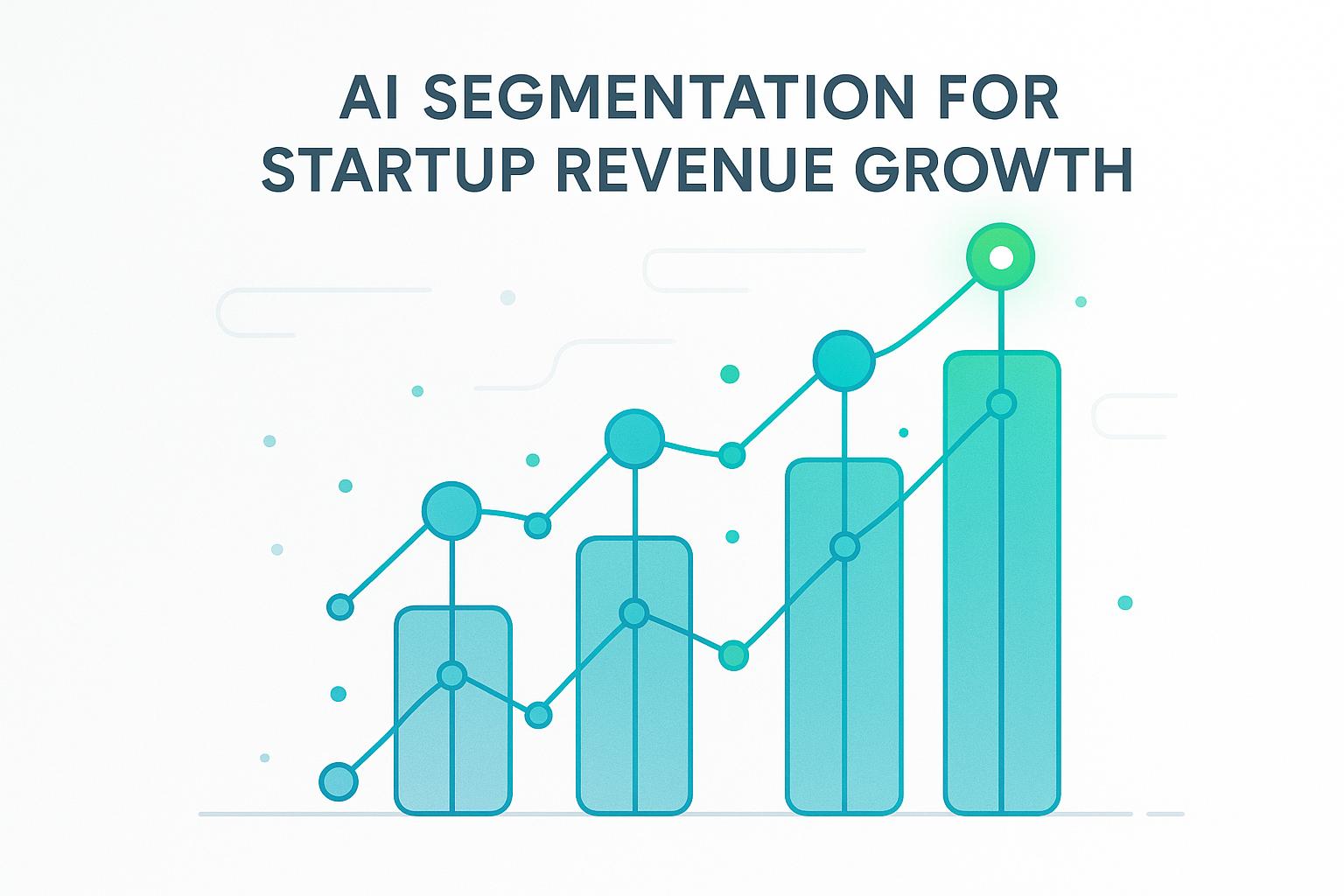AI-driven compliance monitoring is transforming how businesses handle regulations, offering faster, more accurate, and scalable solutions compared to manual methods. For U.S. startups and SMBs, compliance is essential to avoid fines, protect reputation, and attract investors. However, traditional manual processes are slow, error-prone, and struggle to keep up with evolving regulations. AI simplifies compliance by automating tasks, reducing errors, and providing real-time updates, helping businesses save time and money.
Key Points:
- AI Advantages: Real-time monitoring, reduced errors, scalability, and lower long-term costs.
- Manual Limitations: Time-consuming, prone to human error, and difficult to scale.
- Cost of Non-Compliance: Average annual cost exceeds $14.82 million; data breaches cost $9.77 million per incident.
- AI Tools: Automate reporting, flag risks, and integrate with financial systems like QuickBooks.
Quick Comparison:
| Criteria | AI-Driven Compliance | Manual Compliance |
|---|---|---|
| Processing Speed | Instant | Time-intensive |
| Error Rate | Low | High |
| Scalability | High | Limited |
| Response Time | Real-time | Delayed |
| Cost Over Time | Lower | Higher |
| Regulatory Updates | Automatic | Manual |
AI is ideal for businesses handling complex or high-volume compliance needs, while manual methods may suffice for smaller operations with simpler requirements. Tools like Lucid Financials offer a bridge, combining automation with human oversight for efficient compliance management.
Real-Time Monitoring of Regulatory and Ethical Compliance with AI
AI-Driven Compliance Monitoring
Artificial intelligence is reshaping how businesses manage regulatory oversight, taking over tasks that once relied on manual processes. By using machine learning and natural language processing, AI-powered compliance systems can monitor regulatory requirements, analyze vast datasets, and flag potential violations before they escalate into costly problems.
How AI Automates Compliance
AI compliance tools simplify tasks that used to demand hours of manual effort. These systems leverage machine learning and analytics to complete compliance-related work faster and with greater precision than human teams. They continuously track regulatory updates and raise alerts about potential issues in real time.
The sheer volume of regulatory updates has skyrocketed in recent years. Back in 2008, financial institutions dealt with about 10 updates daily. By 2016, that number had surged to over 200 updates per day. AI systems excel in managing this flood of information, tracking changes as they happen and notifying businesses about new requirements.
AI also automates the creation of regulatory reports, pulling data directly from financial systems to generate reports in minutes. This eliminates the need for time-consuming manual data compilation from multiple sources.
Moreover, AI tools analyze historical compliance data to detect patterns that might indicate legal risks. For instance, one federal agency used AI bots to cross-reference tax filings, procurement records, and internal metrics, cutting audit cycle times by over 60%. This not only improved data accuracy but also freed up compliance teams to focus on more strategic tasks.
This level of automation brings impressive gains in both efficiency and accuracy, as explored in the next section.
Key Benefits of AI
The advantages of AI-driven compliance monitoring are game-changing, especially for businesses looking to scale efficiently. One of the biggest improvements comes in accuracy. In 2022, over 59% of compliance violations flagged by the U.S. Federal Reserve stemmed from incorrect data in required filings. AI systems, which operate based on predefined algorithms and learning models, significantly reduce human error and ensure consistent accuracy in every task performed.
Efficiency is another standout benefit. Companies using AI for compliance have cut manual efforts by 78%. For example, AI streamlines access certifications, shortening campaign completion times by an average of 65% while boosting precision. These efficiency gains translate directly into cost savings - 65% of compliance and risk professionals believe automating manual processes reduces both complexity and expenses.
Real-time monitoring is where AI truly shines. Businesses using real-time compliance systems have seen a 35% drop in regulatory fines. In anti-money laundering (AML) monitoring, AI reduces false-positive alerts by up to 75%.
AI also plays a critical role in reducing risks. It cuts security risks by 85% and lowers compliance-related incidents by 40%. For companies facing potential fines in the millions, these reductions can be transformative.
Scalability is another key advantage. AI compliance tools are designed to handle growing data volumes as businesses expand. They can process far more data points than human auditors, identifying patterns and anomalies that traditional methods might miss.
These benefits are amplified when AI systems integrate seamlessly with financial tools.
Integration with Financial Systems
AI compliance platforms are designed to work seamlessly with existing financial tools, offering unified monitoring and reporting. They connect with popular platforms like QuickBooks, Xero, and payroll systems, ensuring access to up-to-date financial data while eliminating information silos.
But the integration goes beyond basic accounting software. AI tools can automate processes like data extraction, validation, and submission for regulatory reporting directly from financial systems. This allows businesses to maintain their current workflows while gaining advanced compliance capabilities.
Lucid Financials is a great example of this approach. It integrates with QuickBooks, payroll systems, and banks to deliver real-time insights and automate compliance alerts. This setup enables AI to monitor transactions, flag suspicious activities, and produce compliance reports without requiring manual data entry or file transfers.
These platforms also perform automatic screenings against global watchlists, including U.S. government sanctions and politically exposed persons (PEPs). When paired with financial systems, this screening happens in real time during transactions, immediately alerting businesses to potential compliance issues.
AI systems can also respond instantly to security threats, helping companies meet cybersecurity compliance standards. This proactive approach transforms compliance from a tedious requirement into a strategic advantage.
For startups and small businesses, these integration capabilities mean they can access enterprise-level compliance tools without the complexity or high costs typically associated with such systems. AI handles the technical heavy lifting, allowing business owners to focus on growth and operations.
Manual Compliance Monitoring
Even in today’s tech-driven world, many organizations still rely on traditional compliance monitoring as a cornerstone of their regulatory oversight. While automated tools are gaining traction, manual methods remain common, especially among smaller businesses or those with tighter technology budgets.
Processes and Characteristics
Manual compliance monitoring revolves around human oversight and detailed record-keeping. It typically involves periodic risk assessments, internal audits, and a heavy focus on documentation to ensure all regulatory requirements are met.
Documentation is the backbone of these systems. Compliance officers use tools like spreadsheets to create reports, track regulatory updates, and revise policies as needed. Regular reviews are a key feature, where compliance teams manually compare business activities against regulatory standards. Employee training is also logged and tracked manually, adding yet another layer of effort. However, these methods come with some clear drawbacks.
Key Limitations of Manual Methods
While manual systems can help establish a basic level of compliance, they come with significant challenges. Human error is one of the biggest risks - manual processes are inherently prone to mistakes or oversights that could lead to regulatory violations.
Time is another major hurdle. Research shows that 40% of compliance teams spend at least four hours each week creating or updating reports for the board. As businesses expand, these systems struggle to keep up. Scaling manual processes to manage larger data volumes or meet the demands of operating in multiple jurisdictions becomes inefficient and nearly impossible.
Another issue is the lack of real-time monitoring. Without automated tools, identifying and addressing compliance issues often takes longer, increasing the risk of delayed responses. Additionally, manual systems are costly to maintain, and staying up to date with ever-changing regulations requires significant time and effort. This can lead to inconsistencies in documentation, making it harder to prove compliance during audits or regulatory reviews.
Compared to AI-powered solutions that offer real-time monitoring and automation, manual methods fall short in terms of efficiency, scalability, and responsiveness. These limitations highlight the growing need for more advanced compliance tools in today’s fast-paced regulatory environment.
AI vs. Manual Compliance Monitoring: Direct Comparison
Let’s take a closer look at how AI-driven compliance stacks up against manual methods. By examining their strengths and weaknesses side by side, businesses can better understand which approach aligns with their goals.
Comparison Across Key Criteria
When you break it down, AI-driven compliance and manual methods differ significantly in how they handle core aspects of monitoring. Here's a snapshot:
| Criteria | AI-Driven Compliance | Manual Compliance |
|---|---|---|
| Processing Speed | Instantly processes massive amounts of data | Requires substantial time for reviewing and analyzing data |
| Error Rate | Low error rates with consistent pattern recognition | Higher likelihood of human errors and oversight |
| Transaction Volume Handling | Easily scales to manage large data sets | Limited by human capacity and working hours |
| Response Time | Real-time monitoring with instant alerts | Delayed detection tied to scheduled reviews |
| Cost Structure | Higher initial investment but lower ongoing costs | Lower upfront costs but higher long-term labor expenses |
| Regulatory Updates | Automatically adjusts to new regulations | Needs manual updates and staff retraining |
| Coverage | Offers 24/7 continuous monitoring | Restricted to business hours and scheduled checks |
The advantages of AI are clear. It handles routine tasks, updates itself to meet regulatory changes, and keeps running around the clock. In contrast, manual compliance often demands constant human intervention, making it slower and more labor-intensive.
Real-world case studies highlight these differences. For example, BNY Mellon partnered with Google Cloud to create an AI model that predicts about 40% of settlement failures in Fed-eligible securities with 90% accuracy. Similarly, Mastercard reduced false positives by up to 200% in fraud detection. These examples underscore the speed and precision AI brings to the table.
AI has another edge: it identifies patterns that human teams might overlook. On the flip side, manual compliance is more prone to costly mistakes. And those mistakes can add up - just one non-compliance event can result in revenue losses as high as $6 million.
Advantages and Limitations of Each Approach
The table lays out the basics, but let’s dig deeper into what each method brings to the table.
AI-driven compliance monitoring is particularly appealing for businesses looking to grow. It scales effortlessly, maintains accuracy, and processes data quickly - even as workloads increase. A report from McKinsey estimates that AI technologies could unlock up to $1 trillion in value annually. And while the upfront costs of AI may seem steep, the long-term savings make it a smart investment. For instance, administrative inefficiencies in U.S. healthcare waste $760 to $935 billion each year - about 25% of total spending. One mid-sized tissue bank that switched to automated monitoring saved 25 staff hours weekly and caught equipment issues early.
"Manual compliance tracking often feels like the simplest and cheapest option, but a look at the real cost tells a different story." – Anthony Ashe
That said, AI isn’t perfect. Implementing these systems requires a significant initial investment and technical expertise. And while AI can handle patterns and repetitive tasks, it still needs human oversight for strategic decisions and complex regulatory interpretations.
Manual compliance, on the other hand, has its strengths, particularly for smaller businesses with straightforward needs. It offers direct human control and can adapt quickly to unique situations without requiring reprogramming. Plus, for organizations with limited transaction volumes, manual methods can be more cost-effective.
However, as businesses expand, the downsides of manual compliance become harder to ignore. It struggles to keep up with growing data volumes and often pulls valuable staff away from their primary roles. For example, in healthcare, 26% of compliance work is handled by clinical staff - time that could be better spent on patient care.
"Compliance automation is not a luxury. It's a necessary step toward financial resilience, operational efficiency, and reduced risk." – Anthony Ashe
The financial risks of non-compliance are staggering. The average cost exceeds $14 billion, factoring in fines, penalties, lost revenue, and damage to reputation. And with data breaches costing an average of $9.77 million per incident, the price of missteps far outweighs the investment in robust monitoring systems.
For startups and small-to-medium businesses in the U.S., navigating complex regulations is no small feat. Choosing a compliance strategy that balances accuracy, efficiency, and scalability is crucial to ensuring long-term success. AI offers a clear path forward for those ready to embrace it.
sbb-itb-17e8ec9
Practical Considerations for Startups and SMBs
Deciding between AI-driven and manual compliance monitoring comes down to understanding your business's transaction volume, the complexity of regulations you face, and how sensitive your data is. Here's a closer look at when each approach makes the most sense.
When to Choose AI-Driven Compliance Monitoring
AI-driven compliance is a game-changer for businesses handling large transaction volumes or navigating intricate regulatory landscapes. If your startup processes hundreds of transactions daily or deals with sensitive data across various channels, AI can manage these tasks effectively and efficiently.
Virginia Rometty, former CEO of IBM, highlights this shift:
"AI is transforming how businesses approach compliance by automating repetitive tasks, reducing human error, and enabling real-time insights".
The numbers back this up. Businesses using AI-driven compliance tools have reduced manual workloads by up to 40%, saving an average of $1.3 million annually. Moreover, companies leveraging AI for incident response have slashed breach containment times by over 50%. AI's ability to process massive amounts of data in real time makes it particularly useful in high-volume settings. If compliance tasks are eating into your team's time and pulling focus away from your core operations, adopting AI solutions can significantly enhance overall productivity.
When Manual Methods May Be Sufficient
Despite AI's advantages, manual compliance methods can still work for smaller businesses with fewer transactions and simpler regulatory needs. For very small operations, these methods might be all you need. However, as your business expands, manual processes often become less practical and more time-consuming.
Brenda Leong, Senior Counsel at the Future of Privacy Forum, emphasizes the shift toward AI in compliance:
"In the next five years, compliance will be defined by its proactive, AI-driven approach. RegTech solutions are moving away from static audits to continuous monitoring, which will be a game-changer".
This trend suggests that even businesses relying on manual methods today may eventually need to consider AI-driven solutions as they grow.
How Lucid Financials Can Help

Lucid Financials offers a bridge between manual processes and AI-powered solutions, combining compliance support with financial planning tools. By integrating with platforms like QuickBooks, payroll systems, and banks, Lucid Financials provides a clear view of your financial data while flagging unusual patterns or discrepancies that could signal regulatory issues.
The platform also includes scenario planning tools that let you model different regulatory outcomes and assess their financial impact. Automated reporting features simplify data compilation, making it easier to transition from manual processes to AI-driven compliance. This flexibility aligns with the idea of tailoring your approach to your business's specific needs.
For startups and SMBs exploring their compliance options, Lucid Financials offers a Free plan to get started. As your business grows, the Starter plan, priced at $45 annually, adds features like QuickBooks integration and advanced scenario planning. Industry benchmarking tools help you stay aligned with compliance standards in your sector. Designed to grow alongside your business, Lucid Financials provides a cost-effective solution without requiring significant upfront investment.
Conclusion
Deciding between AI-driven and manual compliance monitoring comes down to your business's specific needs - transaction volume, regulatory challenges, and available resources all play a role.
Take Tide, for example. They managed to cut a 50-day manual GDPR process down to just hours. Or consider BNY Mellon, which uses AI to predict 40% of settlement failures with an impressive 90% accuracy rate. These examples highlight how AI can dramatically reshape compliance efforts.
Still, as Don Johnson from Ernst & Young LLP points out, AI efficiency alone isn’t enough. Compliance professionals must pair AI tools with expert judgment. This is especially critical given that generative AI can sometimes produce inaccurate summaries, with error rates ranging from 3% to 27% when summarizing facts. To counter this, businesses need solid review processes to ensure AI-generated insights are interpreted correctly and responsibly.
Striking the right balance between automation and human expertise is key to building effective compliance strategies.
Key Takeaways
Platforms like Lucid Financials demonstrate how AI can work hand-in-hand with human oversight to strengthen compliance efforts. Manual monitoring still has its place, especially for smaller businesses with simpler regulatory needs and fewer transactions. However, as businesses grow and face more complex challenges, manual processes often hit their limits.
The best results come from combining AI’s speed and scalability with human judgment. To do this, organizations should focus on strong data governance, regularly validate AI outputs, and use AI as a tool to support, not replace, skilled professionals. With 81% of professionals believing AI has a role in their work, the trend clearly leans toward adopting AI while keeping human oversight intact.
For startups and small-to-medium businesses (SMBs) making this transition, tools like Lucid Financials offer a practical solution. These platforms integrate easily with existing financial systems and provide tools like scenario planning, helping businesses ease into AI-driven compliance while staying in control of their data and regulatory obligations.
The future of compliance monitoring lies in using AI to handle routine tasks while relying on human expertise for the nuanced, high-stakes decisions. This strategic integration ensures businesses stay efficient, accurate, and adaptable in an ever-changing regulatory landscape.
FAQs
How does AI-driven compliance monitoring outperform manual methods in accuracy and efficiency?
AI-powered compliance monitoring brings a new level of precision and speed by automating tasks that often lead to human mistakes. These systems conduct real-time checks, flag compliance issues more quickly, and minimize the chances of anything slipping through the cracks. Thanks to their ability to process massive amounts of data rapidly and consistently, they deliver results you can count on.
Beyond just improving accuracy, AI simplifies workflows by taking over repetitive tasks. This not only saves time but also helps cut down on operational expenses. Unlike traditional manual processes, AI offers round-the-clock monitoring and the ability to scale effortlessly, making it a perfect fit for businesses aiming to keep pace in today’s fast-moving, data-driven world.
What challenges might businesses encounter when using AI for compliance monitoring?
Challenges in Using AI for Compliance Monitoring
Deploying AI for compliance monitoring comes with its fair share of obstacles. One major concern is bias in AI models, which can result in decisions that are unfair or inconsistent. This issue often stems from the data used to train these systems, reflecting existing biases or gaps.
Another significant challenge is the lack of transparency in how certain AI systems function. When the decision-making process of an AI model is opaque, it becomes difficult to interpret or justify its outcomes - something that’s particularly critical in compliance scenarios.
Data privacy and security also demand attention, especially when sensitive information is involved. Organizations must ensure that their AI systems are designed to handle such data responsibly. On top of that, keeping up with changing regulations is essential to ensure that AI tools remain compliant over time.
Lastly, the quality of data used to train AI models plays a crucial role. If the data is incomplete, inaccurate, or poorly managed, it can undermine the system's performance and reliability.
To address these challenges, companies should prioritize robust governance frameworks, enforce ethical standards, and implement continuous monitoring to ensure their AI systems meet compliance requirements effectively.
How can small businesses with basic compliance needs affordably switch from manual to AI-driven compliance monitoring?
Small businesses with straightforward compliance requirements can benefit from AI-driven compliance tools without breaking the bank. By automating repetitive tasks, minimizing manual errors, and saving valuable time, these tools help streamline operations while keeping expenses in check - perfect for businesses with limited resources.
Many AI solutions tailored for startups and small businesses come with low initial costs and scalable features. This makes them an accessible option for simplifying compliance processes. By cutting down on manual work, companies can redirect their energy toward growth initiatives while ensuring their compliance monitoring remains accurate and dependable.


